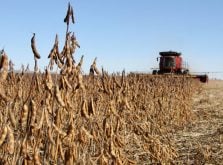Saskatchewan’s failed ethanol venture cost taxpayers more than $860,000, according to an access-to-information request released by the opposition April 23.
Saskatchewan Party leader Brad Wall said a firm deal should have been reached before the government spent the money.
The plan to build a $55 million ethanol plant at Belle Plaine between Regina and Moose Jaw was announced with much fanfare in October 2002. But the government’s private partner, Broe Companies of Denver, Colorado, was never able to put its 60 percent share of the financing in place.
“Let’s take a look at the costs of this project,” Wall said in the legislature. “Project management fees, $438,000; consulting and public relations, $181,000; legal fees, $171,000; damage to the premier’s credibility – priceless. There are some things that money can’t buy but, Mr. Speaker, for everything else the premier has the taxpayers’ MasterCard – $866,000.”
Read Also

Manitoba extends Crown land rent freeze
Manitoba government links the continued rental rate freeze on grazing and forage leases to economic and environmental challenges facing the industry
Wall said premier Lorne Calvert should apologize for using the community of Belle Plaine and Regina school children. Among the costs was a bill from a bus company for transporting children to the proposed site of the plant.
The total cost of the effort was $2.1 million, split 60-40 with Broe. It includes more than $673,000 for engineering and design and $225,000 for site surveying and preparation work.
Industry and resources minister Eric Cline said the $866,540 bill was the cost of doing due diligence for a project of that size. The Belle Plaine plant was to be the first of three.
“You’re going to have some upfront costs that really can’t be avoided going into a venture like this,” he told reporters.
Cline added that private business has stepped up to the plate since the government effort failed, notably ethanol facilities planned for Lloyd-minster and Weyburn, Sask.
West Nile vaccine proves beneficial
By Ian Bell
Brandon bureau
news
Research has shown that a vaccine for horses against West Nile virus is effective.
The potentially deadly virus became widespread across the Prairies in 2003, with more than 400 confirmed cases in horses. The only vaccine available to horse owners in Canada is a killed virus vaccine by Wyeth Animal Health.
The Western College of Veterinary Medicine in Saskatoon based its research on field studies done in Western Canada last summer.
“We have a vaccine that works and we have data to show it works,” said Hugh Townsend, a veterinary epidemiologist at the college.
The vaccine was approved in Canada last year, but there were questions about its effectiveness, especially considering the $50 cost of the two doses that are needed when a horse has not been vaccinated the previous year, which doesn’t include paying veterinarian to give the vaccination.
Townsend said the studies last summer addressed doubts about the vaccine by showing that the consequences of exposure tended to be far less severe for horses with the vaccination than for those without. It was found that an unvaccinated horse was 25 to 30 times more likely to develop clinical signs of West Nile than a vaccinated horse.
Symptoms of West Nile in horses can include stumbling, limb paralysis, listlessness, head shaking and fever. In extreme cases, death can result.
Protective measures
Researchers found that a high percentage of prairie horses were exposed last summer, reaching as high as 85 percent in some areas.
The vaccination doses are given three to four weeks apart. Protective immunity develops two to four weeks after the second injection.
Horses should be vaccinated in spring or early summer so the immunity is well established before the period of greatest risk.
The mosquito species Culex tarsalis is considered the main vector for the virus. When the first generation appears in early spring, it generally prefers the blood of birds rather than horses and people.
However, the next generation tends to shift its preference from birds to horses and humans by mid-July.
It appears that shift coincides with the time when birds that hatched in the spring have matured to the point where they can fly and leave their nests, making it more difficult for mosquitoes to prey on them.
“The feeling is that when birds become harder to find, the mosquito switches to a mammalian species,” said Tasha Epp, a master’s student at the veterinary college who tracked the spread of the virus in Saskatchewan horses last year.
As the summer progresses, a greater percentage of mosquitoes carry West Nile, which presents a risk that lasts at least into September.
By vaccinating horses by the middle of June, the immunity should be well established by the beginning of July.
Since the immunity lasts for at least six months, horses vaccinated in spring or early summer should be protected until well beyond the end of the mosquito season.
Last year’s studies found that West Nile tended to occur in horses most often in August and September.















